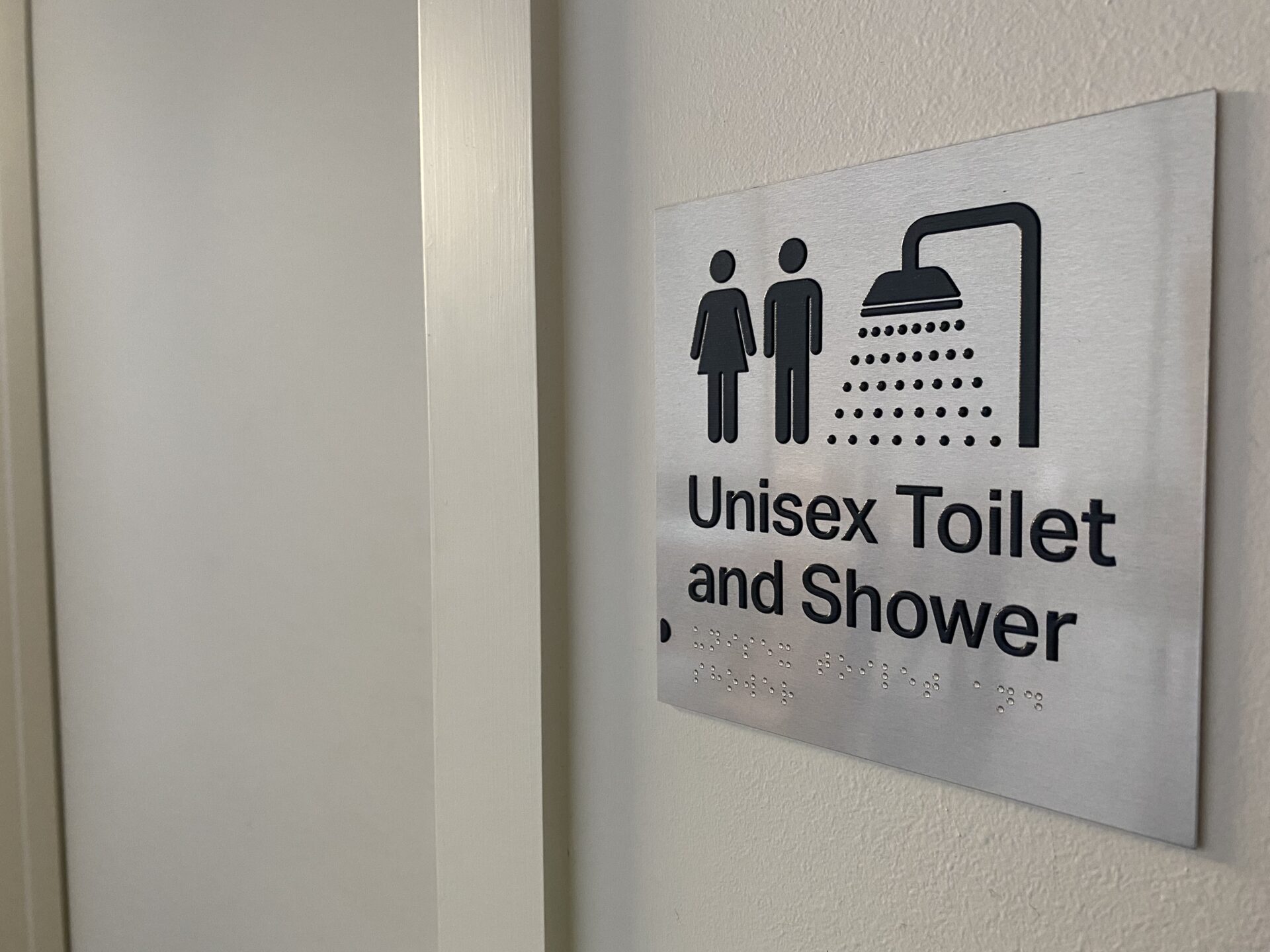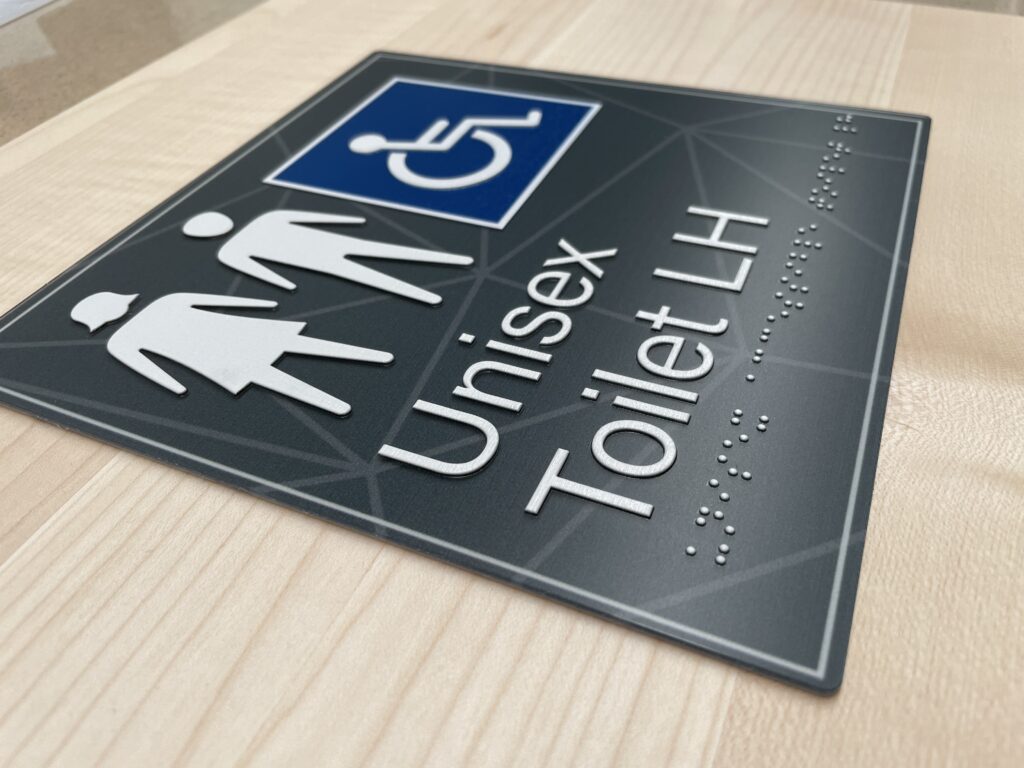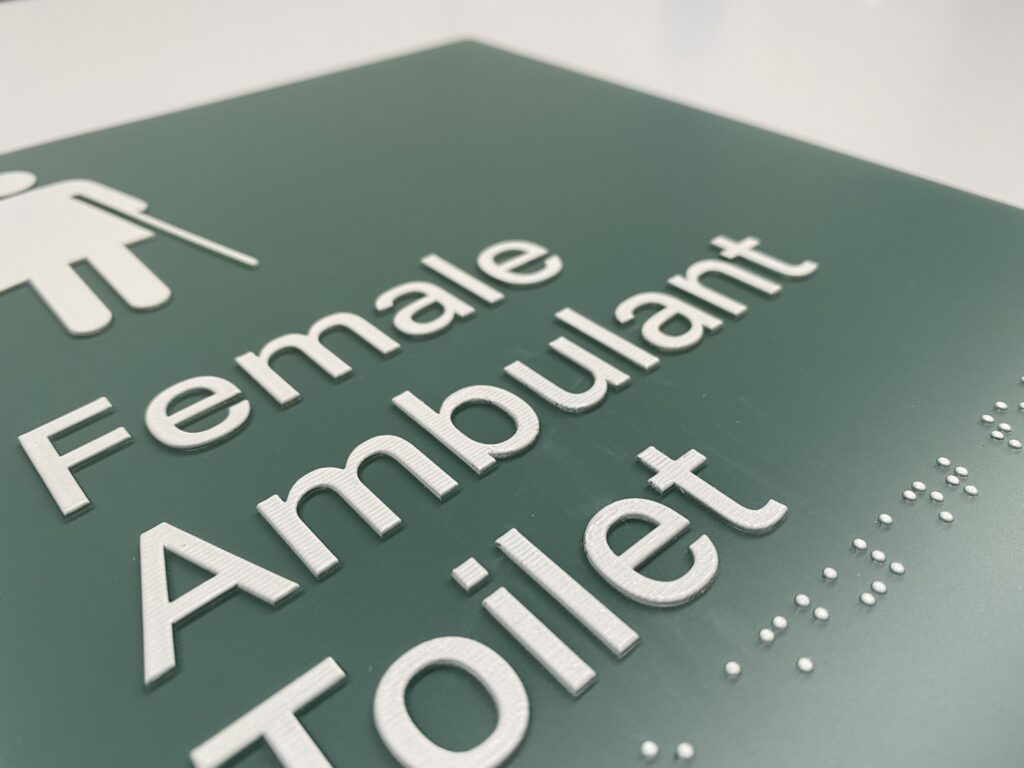

Braille signs, despite being used by a relatively small percentage of the population, play a crucial role in improving the lives of visually impaired individuals. Beyond their functional purpose, Braille signs offer several benefits and contribute to a more inclusive and aesthetically pleasing environment. Here’s an overview:
Accessibility and Independence: Braille signs provide important information in a tactile format, allowing visually impaired individuals to navigate public spaces independently. These signs convey essential information about room numbers, directions, restroom facilities, emergency exits, and more. By having access to Braille signage, individuals with visual impairments can move through various environments with greater confidence and autonomy.
Inclusion and Equal Opportunity: Braille signs promote inclusivity and equal access for visually impaired individuals. They ensure that individuals with visual impairments have the same opportunity to understand and interact with their surroundings as their sighted counterparts. This accessibility helps bridge the information gap and allows visually impaired individuals to participate fully in public spaces, such as offices, schools, transportation hubs, and public buildings.
Safety and Emergency Preparedness: Braille signs play a vital role in ensuring the safety of visually impaired individuals during emergencies. They provide essential instructions and guidance, including evacuation routes, emergency exits, and safety procedures. By having access to this critical information in Braille format, individuals with visual impairments can respond appropriately during emergency situations, enhancing their personal safety.
Empowerment and Inclusivity Awareness: The presence of Braille signs raises awareness and understanding among the general population about the needs and abilities of visually impaired individuals. It fosters a culture of inclusivity and sensitivity, encouraging society to consider diverse needs when designing public spaces. This increased awareness can lead to the implementation of other inclusive features, such as auditory cues or tactile paving, which further benefit individuals with visual impairments.
Aesthetics and Design: Braille signs, when integrated into well-designed environments, can contribute to the overall aesthetic appeal. Architects and designers have recognized the importance of seamlessly incorporating Braille signs into their projects, resulting in visually pleasing and harmonious designs. The careful integration of Braille signage can enhance the overall aesthetic quality of a space, demonstrating that accessibility and beauty can coexist.
Universal Design: Braille signs align with the principles of universal design, which aims to create environments that are accessible and usable by the widest range of individuals. By integrating Braille signs into public spaces, businesses, and institutions, they demonstrate a commitment to inclusivity and a welcoming environment for everyone, regardless of their visual abilities.
While Braille signs may cater to a relatively small percentage of the population, their impact on the lives of visually impaired individuals is substantial. By providing access to crucial information, promoting independence and safety, fostering inclusivity awareness, and contributing to the aesthetics of a space, Braille signs create a more inclusive and equitable society for all.
Here are some general considerations for installing Braille signs in Australia:
Location and Mounting Height:
Braille signs should be mounted adjacent to the latch side of the door, either on the wall or on the door itself.
The mounting height may vary depending on the specific Australian Standard and building code requirements. In Australia, the Australian Standard AS 1428.1:2009 provides guidelines for accessible design, including Braille signage. It recommends a mounting height of 1400-1700 mm above the finished floor.
Size and Layout:
The overall size of the sign should be determined by the amount of information it needs to convey and should be designed to ensure easy readability and legibility.
The Braille characters should be a standard size, typically 6.3 mm (0.25 inches) in height.
Braille Specifications:
Braille signs in Australia should comply with the requirements specified in the Australian Standard AS 1428.1:2009.
Grade 2 Braille is generally used, which is a more condensed and efficient form of Braille.
The dots of the Braille cells should be rounded and well-defined, maintaining proper spacing and alignment.
Contrast and Color:
The Australian Standard AS 1428.1:2009 provides guidelines for the contrast requirements of Braille signs.
The contrast between the background and the tactile characters is crucial for legibility.
It is recommended to use high-contrast color combinations, such as black characters on a white background or white characters on a dark background.
The Australian Standard does not provide specific contrast requirements in terms of light reflectance value (LRV), but it emphasizes the need for a visually distinct contrast.
Raised Characters and Pictograms:
The tactile characters should be raised, making them easily distinguishable by touch.
The raised characters should have a minimum height of 0.5 mm from the sign’s background.
Pictograms, if included, should be clear and easily recognizable.
It is important to consult the specific regulations and guidelines set by the Australian Building Codes Board (ABCB) and refer to the Australian Standard AS 1428.1:2009 for comprehensive and up-to-date information regarding the installation of Braille signs and contrast requirements in Australia.
There are several methods of creating Braille signs, each with its own advantages and considerations. Here are some common methods used to produce Braille signs:
Braille Embossing:
Braille embossing involves pressing or stamping individual Braille dots onto a material, creating tactile characters.
The embossing process typically utilizes a specialized Braille embosser, which has a series of pins or styluses that create the raised dots.
This method is commonly used for producing Braille signs on materials like plastic, metal, or paper.
Braille embossing provides a durable and precise result, ensuring clear and readable Braille characters.
Photopolymer:
Photopolymer is a printing process that combines ink and a light-sensitive polymer to create Braille characters.
The photopolymer method involves using a specialized machine that exposes the polymer to UV light through a stencil or mask, curing the material and forming the Braille dots.
This method is often used for producing Braille signs on materials like acrylic or metal.
Photopolymer offers a visually appealing finish and can incorporate various colors and designs alongside Braille.
Thermoforming:
Thermoforming involves heating a plastic sheet and molding it into the desired shape, including Braille characters.
A Braille template or mold is used to create the raised dots during the thermoforming process.
This method is commonly used for producing Braille signs on materials like acrylic or plastic.
Thermoformed Braille signs provide durability and can be customized with various colors and designs.
3D Printing:
3D printing technology can be utilized to create Braille signs by printing the individual Braille dots layer by layer.
The 3D printing process can be adapted to different materials like plastic or resin.
This method allows for customization and flexibility in terms of sign design and size.
3D printed Braille signs can offer a visually pleasing and tactile experience.
It is important to note that when creating Braille signs, the specified standards and guidelines for Braille characters’ size, spacing, and legibility should be followed. These standards ensure consistency and readability for visually impaired individuals.
When choosing a method for creating Braille signs, factors such as durability, material compatibility, production volume, and desired aesthetic should be considered. Consulting accessibility standards and working with experienced professionals can help ensure the production of high-quality and compliant Braille signs.